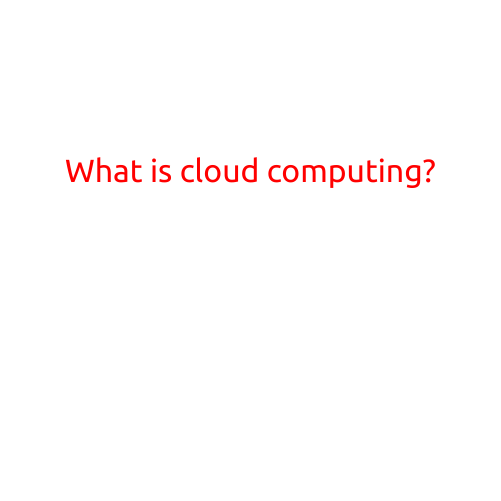
What is Cloud Computing?
In today’s technology-driven world, the term “cloud computing” has become a buzzword in the IT industry. But what exactly is cloud computing, and how does it work? In this article, we’ll delve into the world of cloud computing, exploring its definition, benefits, and applications.
What is Cloud Computing?
Cloud computing is a model of delivering computing services over the internet, where resources such as servers, storage, databases, software, and applications are provided as a service to users on-demand. Instead of having to manage and maintain physical hardware and software, cloud computing allows users to access these resources on a pay-as-you-go basis.
Key Characteristics of Cloud Computing
Cloud computing is characterized by several key features:
- On-demand self-service: Users can provision and de-provision resources as needed, without requiring human intervention.
- Broad network access: Resources are accessible over the internet or via a private network.
- Resource pooling: Resources are pooled together to provide a multi-tenant environment, where resources can be dynamically allocated and re-allocated based on demand.
- Rapid elasticity: Resources can be scaled up or down quickly and easily in response to changing workload demands.
- Measured service: Users only pay for the resources they use, rather than having to purchase and maintain physical infrastructure.
Types of Cloud Computing
There are three main types of cloud computing:
- Public Cloud: A public cloud is a multi-tenant environment, where resources are shared among multiple users and are managed by a third-party provider. Examples of public cloud providers include Amazon Web Services (AWS), Microsoft Azure, and Google Cloud Platform (GCP).
- Private Cloud: A private cloud is a single-tenant environment, where resources are dedicated to a single organization and are managed internally or by a third-party provider.
- Hybrid Cloud: A hybrid cloud combines public and private cloud environments, allowing users to take advantage of the benefits of both models.
Benefits of Cloud Computing
Cloud computing offers numerous benefits, including:
- Scalability: Cloud resources can be quickly scaled up or down to meet changing workload demands.
- Cost-effectiveness: Users only pay for the resources they use, reducing capital and operating expenses.
- Reliability: Cloud providers typically offer high levels of uptime and redundancy, ensuring that resources are always available.
- Flexibility: Cloud resources can be accessed from anywhere, at any time, and on any device.
- Security: Cloud providers typically offer robust security features, including data encryption, firewalls, and access controls.
Applications of Cloud Computing
Cloud computing has a wide range of applications, including:
- Software-as-a-Service (SaaS): Cloud-based software applications, such as Microsoft Office 365 and Salesforce.
- Platform-as-a-Service (PaaS): Cloud-based platforms for developing and deploying applications, such as Google App Engine and Heroku.
- Infrastructure-as-a-Service (IaaS): Cloud-based infrastructure for building and deploying custom applications, such as Amazon Elastic Compute Cloud (EC2) and Rackspace.
- Big Data and Analytics: Cloud-based storage and processing solutions for large-scale data sets and analytics workloads.
- Artificial Intelligence and Machine Learning: Cloud-based AI and ML services and platforms, such as Google Cloud AI Platform and Amazon SageMaker.
Conclusion
Cloud computing has revolutionized the way we think about computing and IT infrastructure. By providing on-demand access to scalable and flexible resources, cloud computing has opened up new possibilities for businesses and individuals alike. Whether you’re looking to reduce costs, increase efficiency, or unlock new opportunities, cloud computing is an important technology to understand and leverage.





